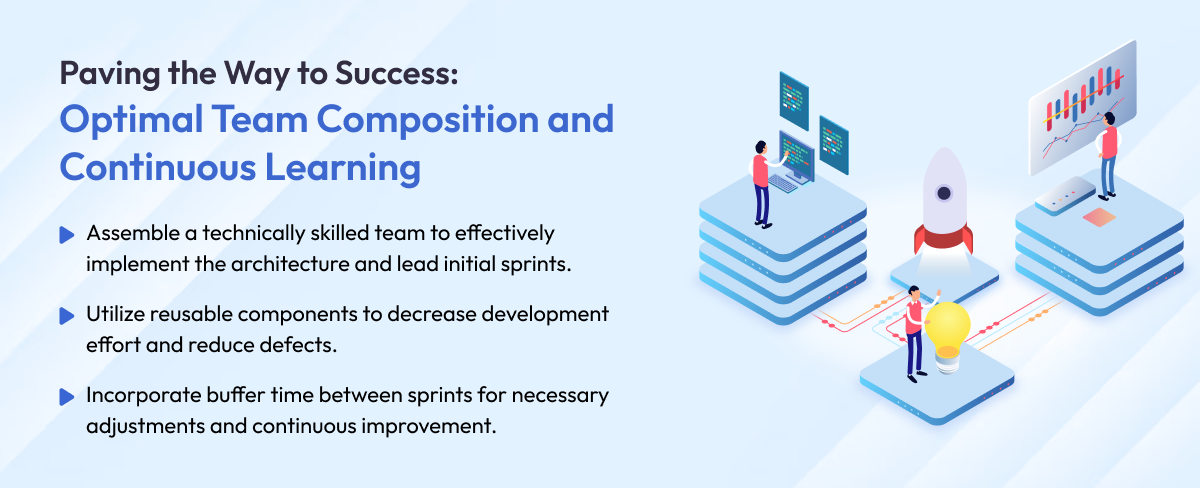Streamlining Software Development: From Proof of Concept to Continuous Learning
In the rapidly evolving technological landscape, businesses consistently aim to create superior custom applications that meet unique needs and distinguish themselves in a competitive market. However, the path to successful delivery within time and budget constraints is often fraught with complexities and challenges. The 2020 CHAOS report by The Standish Group revealed that only 34% of projects were successful, indicating that project execution needs significant enhancements. Employing robust strategies that streamline development processes, optimize resource allocation, and deliver exceptional client satisfaction is, therefore, imperative.

Crafting the Blueprint: Proof of Concept and Feature Prioritization
The journey toward high-quality application delivery begins by developing a Proof of Concept (PoC). As evidenced by the project failures reported by CIO in 2016, 37% were due to a lack of clear goals. A PoC addresses major technical challenges, provides a realistic estimation, and ensures a clear project trajectory. For instance, when LinkedIn redesigned its mobile app architecture, the development team used PoC to validate its new design and mitigate technical risks. This strategic approach resulted in a more reliable, efficient, and scalable application.
Prioritizing features by categorizing them as “must-have,” “nice-to-have,” and “can-be-added-later” is another fundamental strategy. The Pareto principle suggests that 80% of the effects come from 20% of the causes. Hence, focusing on the 20% ‘must-have’ features can deliver significant value, ensuring essential functionality on initial release. Facebook’s “move fast and break things” motto embodies this ethos, highlighting the importance of delivering key features swiftly and iterating over time.
Building a Solid Foundation: QA Involvement and Prototype Development
Involving the Quality Assurance (QA) team from the outset fosters collaboration and improves testing quality. The QA team can optimize test cases and reduce redundancy by aligning early with business requirements. A study published in the IBM Systems Journal found that defects identified in the design phase are up to 100 times less expensive to fix than those discovered in the production phase. Thus, early QA involvement can significantly reduce costs.
Developing a comprehensive prototype of the application enables early validation of business requirements. A classic example is Twitter, which started as a simple prototype and evolved through user feedback and iterative development. Prototypes minimize rework by capturing all necessary functionalities upfront and ensure a smoother development process.

Paving the Way to Success: Optimal Team Composition and Continuous Learning
Establishing a capable kick-off team comprising technically skilled members lays the groundwork for success. According to PMI’s 2018 Pulse of the Profession report, having technically skilled project managers contributes to project success 40% more than without them. This team can effectively implement the technical architecture, ensure a strong start, and drive initial sprints to completion.
Another proven strategy is leveraging reusable components. Research by Capers Jones indicates that systems with reusable components have 40% lower development effort and 30% fewer defects. Therefore, utilizing reusable components saves time and enhances the application’s quality.
Incorporating buffer time between sprints allows for necessary adjustments and priority shifts, enhancing the project’s flexibility and responsiveness. A retrospective after each sprint enables continuous improvement by identifying successful strategies and areas for refinement, fostering a culture of continuous learning.

Sustaining Success: Proactive Communication and Automatic Code Documentation
It is imperative to foster transparency, collaboration, and real-time progress tracking through proactive communication with customers, subdividing teams into smaller groups, and daily stand-up meetings. For example, Amazon’s ‘two-pizza’ rule emphasizes small team sizes for effective communication and decision-making.
Finally, automatic code documentation tools enhance project understanding and facilitate future maintenance. A study by TIOBE Index showed that projects with proper documentation had a 19.8% lower defect density.
In conclusion, by implementing these strategies, software development companies can optimize their processes, ensure the timely delivery of high-quality custom applications, and manage budgets effectively. These strategies, coupled with a data-driven and customer-centric approach, can significantly improve project outcomes, leading to satisfied clients and a competitive edge in the ever-evolving software development industry.
References:
-
The Standish Group, “CHAOS Report 2020,” The Standish Group International, Inc, 2020,
-
Improving LinkedIn’s Feed Experience with Architecture,” LinkedIn Engineering, 2020
-
Project Management Institute, “Pulse of the Profession 2018,” PMI, 2018,
-
Capers Jones, “Reuse and Productivity in Integrated Computer Systems,” Reifer Consultants, 1986,
We can help!
Why Scrum Fits Like A Glove
#Customapplicationdevelopment
Mvps - A Silver Bullet In Software Development
#Customapplicationdevelopment
The Green Revolution: A Tale Of Technology Giants Striding Toward Sustainability
#Customapplicationdevelopment



